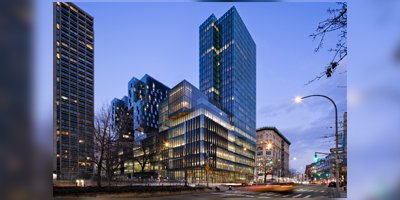The John A. Paulson Center at New York University (NYU) is a new multipurpose campus building aligned with the university’s Climate Action Plan, aiming to be one of the greenest urban campuses in the US.
Located in Greenwich Village, the Paulson Center replaces the outdated, one-story Coles Sports and Recreation Center. It serves as the gateway between New York and the university.
The building sets a new paradigm for multipurpose facilities at NYU, including an athletic complex, classrooms, study spaces, theater and music performance spaces, first-year student and faculty residential towers, and a new common area. The building embodies the spirit of the university and encourages new ways of learning, connecting, working, playing and living.
Designed jointly by architecture firms, Davis Brody Bond and KieranTimberlake, in support of NYU’s Climate Action Plan, the 68,000 m2 The project’s (735,000 sq ft) sustainable design strategies reduce greenhouse gas (GHG) emissions, water consumption and the amount of waste generated during construction and operations.
As part of NYU’s plans for carbon neutrality by 2040, the team incorporated several energy-efficient strategies and systems:
- Expansion of the Cogeneration Plant (CoGen), NYU’s natural gas-fired power plant. It reduces energy and carbon consumption while providing efficient heating and cooling to the building.
- Use of residual heat from the CoGen plant for dehumidification of buildings. This also reduces the plant’s potable water consumption, where waste heat would be removed through cooling towers.
- Creation of a thermal buffer to improve comfortable circulation spaces around the perimeter of the building, with air-conditioned spaces located further inside the building.
- Custom frit pattern design with 50 percent more density to reduce the amount of solar radiation entering the south and southwest facades.
- Built-in carbon footprint assessment, using KieranTimberlake’s proprietary software, which allowed the design team to make appropriate adjustments.
- Reduce the impacts of the construction life cycle by collecting demolition and construction waste for recycling.
Frit glass, a patterned glass with a ceramic frit applied to the clear glass, helps reduce bird collisions and provides clear visibility to building perimeter areas. To improve bird safety, the glass has a denser frit design on exterior corners, lower building levels and areas near green roofs.
The approach to bird protection was informed by expert insights from the American Bird Conservancy and the Bird-Safe Building Alliance. Additionally, the building’s exterior lighting is designed to illuminate the street and sidewalks, while minimizing disruption to bird migration patterns by directing light downward rather than outward.
Approximately 2,300 m2 (25,000 square meters) of green roofs reduce stormwater runoff and minimize the urban heat island effect while enhancing views, providing outdoor space and encouraging urban biodiversity.
In addition to an efficient filtration system, the John A. Paulson Center uses many design features and processes to ensure the highest possible air quality:
- Implementation of strict processes to maintain indoor air quality throughout construction.
- Specify low-emission materials throughout the building, including furniture, fixtures and most paints, carpets, adhesives and ceiling materials.
- Conduct an air quality assessment and address any issues to maximize indoor air quality.
- GreenCleaning, a rigorous protocol for building maintenance that emphasizes air quality.
Each of the spaces in the John A. Paulson Center is built with an appropriate structural system. The five-story performing arts podium anchors the building to its site, an entire block where the Jerome S. Coles Sports Center once stood.
The steel frame structure features double walls, floating floors and specially detailed pitched ceilings to acoustically isolate the premises from noise and vibration. The upper floors hang from a fifth-floor transfer truss at the south end of the building, allowing for a two-story, column-free entrance hall on Bleecker Street.
Two lower levels provide space for sports facilities including four basketball courts and a six-lane swimming pool. Four steel trusses span the courts to create an open space large enough for National Collegiate Athletic Association (NCAA) regulation. The perimeter walls and slab of the cellar were designed as a waterproofed ‘bathtub’, with caissons drilled into the underlying bedrock to support the building above.
An 18-storey teacher’s housing tower rises from the southern end of the podium, while a 13-storey dormitory block sits in the central part of the podium. Residential structures are framed with conventional structural steel and beam-slab floor systems that combine proprietary steel forms with precast concrete planks. The system allowed rapid assembly, reduced dead load and minimized construction depth.
Acoustic insulators between the foundation and the steel structure of the southern two-thirds of the structure attenuate the vibrations and noise generated by an adjacent subway tunnel.

